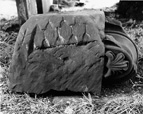Select a site alphabetically from the choices shown in the box below. Alternatively, browse sculptural examples using the Forward/Back buttons.
Chapters for this volume, along with copies of original in-text images, are available here.
Object type: Part of hogback, in two pieces
Measurements:
Stone a: L. 73.4 cm (29 in); W. 30.5 > 24.1 cm (12 > 9.5 in); D. 43.2 > 41.3 cm (17 > 16.25 in)
Stone b: L. 78.7 cm (31 in); W. 25.4 > 24.1 cm (10 > 9.5 in); D. 44.4 > 40.6 cm (17.5 > 16 in)
Stone type: Medium-grained red sandstone (St Bees sandstone)
Plate numbers in printed volume: 533 - 8
Corpus volume reference: Vol 2 p. 143
(There may be more views or larger images available for this item. Click on the thumbnail image to view.)
Hogback, type h, but with zoomorphic ornament.
A (long): Two rows of tegulation type 8 on the curving roof are bounded at the gable-end by a double cable moulding. On the wall below the curving eaves are the remains of interlocked ribbon animals with contoured outlines to their bodies. In the upper left corner a bird-like head terminates one of these beasts; it has a slit mouth and elliptical eye. The zoomorphic ornament is bounded at the gable-end by a continuation of the double cable moulding of the roof.
B (end): The gable-end is slightly hipped. Within an arched frame formed by a double cable moulding the ornament consists of part of an irregularly set out triquetra worked in a contoured strand.
C (long): On the curved roof are two lines of tegulation type 8 bounded at the gable-end by a double moulding with grooved ornament suggesting cabling. On the wall are the worn remains of interlocked and contoured ribbon animals. At the right is a trilobate tail with, below, the probable remains of a canine head with round eye. This zoomorphic ornament is bounded at the gable-end by a continuation of the double cable moulding of the roof.
D (end): Within an arched frame created by a double cable moulding is a triquetra formed by a contoured strand; the inner lines of the lower curves are interrupted by a semi-circular indentation.
This was an elaborate monument whose ambition is signalled by the double cable moulding and its unparalleled form of tegulation. The ornament on the gable-ends is Jellinge-derived in its contouring and semi-circular indentations whilst the crossing composition of the ribbon animals can be closely paralleled in the Jellinge art of Scandinavia (Wilson and Klindt-Jensen 1980, pls. XXIV–XXV). Such animal ornament on the sides of this class of monument is rare: Gosforth 5, Brompton in Yorkshire and Derby provide parallels (Lang 1984, 125, 129), though in none of these cases are the details identical. Gosforth 4 and 5 with Cross Canonby 5 offer local analogues for the flat, sloping gable-ends.



